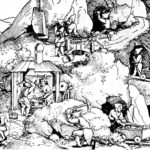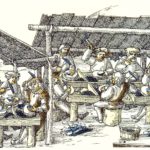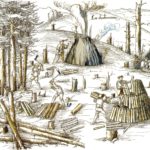8. Mining landscape
In the Middle Age, the slope of the mining area being densely wooden today, was completely deforested. At that time, the wooden was used for the charcoal burning and for the construction of the galleries. Workshops and huts were part of the mining area, too, and were placed between the numerous entrances to the shafts and galleries on artificial terraces or levelled heaps. Up to now, no archaeological excavations have taken place in the mining area of “Ehrenstetter Grund”, therefore, we do not exactly know the place of the workshops and huts.
Unlike today, however, the valley was filled with noise in the Middle Age. You could always hear the hammering of the forgers re-sharpening the mineworkers’ chisels which were blunt from their hard work. In most cases the forgers worked in simple wooden huts equipped with a smith’s heart and an anvil.
Additionally, you could hear the hammering of the separators. After the ore-rich stone had been extracted, it was separated from the waste rock manually. For this reason, the stone was broken into small pieces with the hammer on big blocks of stone. Then the ore was selected and brought to the valley for the further treatment. The worthless rock was thrown away on the heap. This separation work was done in close proximity of the galleries and shafts.
However, on the slope there is a further, third open shaft. It is only 8 m deep and reaches directly a lead-silver vein.


